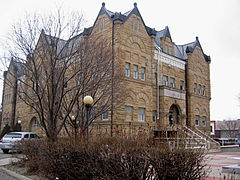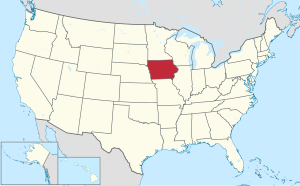Shelby County is a county located in the U.S. state of Iowa. As of the 2020 census, the population was 11,746.[1] The county seat is Harlan.[2] Its name is in honor of Isaac Shelby, the first Governor of Kentucky.
Shelby County | |
|---|---|
 | |
 Location within the U.S. state of Iowa | |
 Iowa's location within the U.S. | |
| Coordinates: 41°40′53″N 95°18′46″W / 41.681388888889°N 95.312777777778°W | |
| Country | |
| State | |
| Founded | 1851 |
| Named for | Isaac Shelby |
| Seat | Harlan |
| Largest city | Harlan |
| Area | |
| • Total | 598 sq mi (1,550 km2) |
| • Land | 598 sq mi (1,550 km2) |
| • Water | 0.6 sq mi (2 km2) 0.1% |
| Population (2020) | |
| • Total | 11,746 |
| • Estimate (2023) | 11,806 |
| • Density | 20/sq mi (7.6/km2) |
| Time zone | UTC−6 (Central) |
| • Summer (DST) | UTC−5 (CDT) |
| Congressional district | 4th |
| Website | shelbycounty |
History
editShelby County was established on January 15, 1851. It was named after General Isaac Shelby, a hero in the American Revolutionary War and the first Governor of Kentucky.
Early settling in Shelby County began in 1848 in Galland's Grove.[3] On February 4, 1855, Shelbyville was designated the county seat. In April 1859, the seat was moved to Harlan. One year later the first courthouse was erected and a second courthouse was constructed in 1875. In 1892, the construction of the present courthouse was begun, this time of stone and three storeys high. The construction was completed in 1893 with the dedication on September 14. The 1892 Shelby County Courthouse and the surrounding buildings are all listed in the National Register of Historic places effective September 23, 1994.[4] In 1978, the building was extensively restored and still serves as the courthouse.
Geography
editAccording to the U.S. Census Bureau, the county has a total area of 591 square miles (1,530 km2), of which 591 square miles (1,530 km2) is land and 0.6 square miles (1.6 km2) (0.1%) is water.[5]
Major highways
edit- U.S. Highway 59
- Iowa Highway 37
- Iowa Highway 44
- Iowa Highway 173
- Iowa Highway 191
- County Highway M16
- County Highway F58
- County Highway F32
- County Highway F24
- County Highway M36
Attractions
editAdjacent counties
edit- Crawford County (north)
- Audubon County (east)
- Cass County (southeast)
- Pottawattamie County (south)
- Harrison County (west)
Demographics
edit| Census | Pop. | Note | %± |
|---|---|---|---|
| 1860 | 818 | — | |
| 1870 | 2,540 | 210.5% | |
| 1880 | 12,696 | 399.8% | |
| 1890 | 17,611 | 38.7% | |
| 1900 | 17,932 | 1.8% | |
| 1910 | 16,552 | −7.7% | |
| 1920 | 16,065 | −2.9% | |
| 1930 | 17,131 | 6.6% | |
| 1940 | 16,720 | −2.4% | |
| 1950 | 15,942 | −4.7% | |
| 1960 | 15,825 | −0.7% | |
| 1970 | 15,528 | −1.9% | |
| 1980 | 15,043 | −3.1% | |
| 1990 | 13,230 | −12.1% | |
| 2000 | 13,173 | −0.4% | |
| 2010 | 12,167 | −7.6% | |
| 2020 | 11,746 | −3.5% | |
| 2023 (est.) | 11,806 | [6] | 0.5% |
| U.S. Decennial Census[7] 1790-1960[8] 1900-1990[9] 1990-2000[10] 2010-2018[11] | |||
2020 census
editThe 2020 census recorded a population of 11,746 in the county, with a population density of 19.6271/sq mi (7.5781/km2). 96.51% of the population reported being of one race. 90.06% were non-Hispanic White, 0.45% were Black, 3.51% were Hispanic, 0.47% were Native American, 0.42% were Asian, 0.03% were Native Hawaiian or Pacific Islander and 5.07% were some other race or more than one race. There were 5,421 housing units, of which 4,981 were occupied.[1]
2010 census
editThe 2010 census recorded a population of 12,167 in the county, with a population density of 20.5931/sq mi (7.9510/km2). There were 5,542 housing units, of which 5,085 were occupied.[12]
2000 census
editAs of the census[13] of 2000, there were 13,173 people, 5,173 households, and 3,703 families residing in the county. The population density was 22 people per square mile (8.5 people/km2). There were 5,459 housing units at an average density of 9 per square mile (3.5/km2). The racial makeup of the county was 98.68% White, 0.10% Black or African American, 0.29% Native American, 0.27% Asian, 0.18% from other races, and 0.48% from two or more races. 0.67% of the population were Hispanic or Latino of any race.
There were 5,173 households, out of which 32.60% had children under the age of 18 living with them, 62.30% were married couples living together, 6.80% had a female householder with no husband present, and 28.40% were non-families. 25.20% of all households were made up of individuals, and 13.60% had someone living alone who was 65 years of age or older. The average household size was 2.49 and the average family size was 2.99.
In the county, the population was spread out, with 26.40% under the age of 18, 5.70% from 18 to 24, 25.20% from 25 to 44, 22.40% from 45 to 64, and 20.40% who were 65 years of age or older. The median age was 40 years. For every 100 females there were 95.90 males. For every 100 females age 18 and over, there were 93.30 males.
The median income for a household in the county was $37,442, and the median income for a family was $44,681. Males had a median income of $29,402 versus $20,296 for females. The per capita income for the county was $16,969. About 4.30% of families and 6.00% of the population were below the poverty line, including 6.00% of those under age 18 and 7.60% of those age 65 or over.
Communities
editCities
editCensus-designated places
editOther unincorporated places
editTownships
editPopulation ranking
editThe population ranking of the following table is based on the 2020 census of Shelby County.[1]
† county seat
| Rank | City/Town/etc. | Municipal type | Population (2020 Census) |
|---|---|---|---|
| 1 | † Harlan | City | 4,893 |
| 2 | Shelby (partially in Pottawattamie County) | City | 716 (727 total) |
| 3 | Elk Horn | City | 601 |
| 4 | Earling | City | 397 |
| 5 | Irwin | City | 319 |
| 6 | Defiance | City | 245 |
| 7 | Panama | City | 235 |
| 8 | Portsmouth | City | 182 |
| 9 | Westphalia | City | 126 |
| 10 | Tennant | City | 78 |
| 11 | Kirkman | City | 56 |
| 12 | Corley | CDP | 31 |
| 13 | Jacksonville | CDP | 29 |
Politics
edit| Year | Republican | Democratic | Third party(ies) | |||
|---|---|---|---|---|---|---|
| No. | % | No. | % | No. | % | |
| 2020 | 4,697 | 69.12% | 1,959 | 28.83% | 139 | 2.05% |
| 2016 | 4,362 | 68.48% | 1,662 | 26.09% | 346 | 5.43% |
| 2012 | 3,911 | 60.33% | 2,469 | 38.08% | 103 | 1.59% |
| 2008 | 3,488 | 54.04% | 2,863 | 44.35% | 104 | 1.61% |
| 2004 | 4,256 | 63.81% | 2,355 | 35.31% | 59 | 0.88% |
| 2000 | 3,655 | 60.83% | 2,179 | 36.26% | 175 | 2.91% |
| 1996 | 3,056 | 51.44% | 2,176 | 36.63% | 709 | 11.93% |
| 1992 | 2,809 | 42.92% | 2,094 | 32.00% | 1,641 | 25.08% |
| 1988 | 3,019 | 51.52% | 2,806 | 47.88% | 35 | 0.60% |
| 1984 | 4,200 | 64.25% | 2,291 | 35.05% | 46 | 0.70% |
| 1980 | 4,147 | 64.03% | 1,892 | 29.21% | 438 | 6.76% |
| 1976 | 3,301 | 52.72% | 2,851 | 45.54% | 109 | 1.74% |
| 1972 | 4,052 | 62.93% | 2,259 | 35.08% | 128 | 1.99% |
| 1968 | 3,886 | 58.65% | 2,365 | 35.69% | 375 | 5.66% |
| 1964 | 2,928 | 41.03% | 4,148 | 58.12% | 61 | 0.85% |
| 1960 | 4,210 | 55.08% | 3,427 | 44.83% | 7 | 0.09% |
| 1956 | 4,425 | 56.78% | 3,300 | 42.35% | 68 | 0.87% |
| 1952 | 5,135 | 64.68% | 2,762 | 34.79% | 42 | 0.53% |
| 1948 | 3,301 | 47.60% | 3,499 | 50.45% | 135 | 1.95% |
| 1944 | 3,873 | 55.86% | 2,978 | 42.95% | 82 | 1.18% |
| 1940 | 4,613 | 54.53% | 3,811 | 45.05% | 36 | 0.43% |
| 1936 | 3,490 | 42.40% | 4,264 | 51.80% | 477 | 5.80% |
| 1932 | 2,478 | 32.86% | 4,940 | 65.52% | 122 | 1.62% |
| 1928 | 3,459 | 48.85% | 3,604 | 50.90% | 18 | 0.25% |
| 1924 | 3,252 | 47.96% | 2,297 | 33.88% | 1,231 | 18.16% |
| 1920 | 4,621 | 70.55% | 1,882 | 28.73% | 47 | 0.72% |
| 1916 | 1,898 | 47.50% | 2,060 | 51.55% | 38 | 0.95% |
| 1912 | 872 | 22.63% | 1,841 | 47.78% | 1,140 | 29.59% |
| 1908 | 1,973 | 49.34% | 1,935 | 48.39% | 91 | 2.28% |
| 1904 | 2,310 | 57.69% | 1,584 | 39.56% | 110 | 2.75% |
| 1900 | 2,182 | 51.47% | 2,010 | 47.42% | 47 | 1.11% |
| 1896 | 2,019 | 47.85% | 2,175 | 51.55% | 25 | 0.59% |
See also
editReferences
edit- ^ a b c "2020 Census State Redistricting Data". census.gov. United states Census Bureau. Retrieved August 12, 2021.
- ^ "Find a County". National Association of Counties. Retrieved June 7, 2011.
- ^ A brief history, Shelby County Iowa website
- ^ Shelby County Attractions
- ^ "US Gazetteer files: 2010, 2000, and 1990". United States Census Bureau. February 12, 2011. Retrieved April 23, 2011.
- ^ "Annual Estimates of the Resident Population for Counties: April 1, 2020 to July 1, 2023". United States Census Bureau. Retrieved April 2, 2024.
- ^ "U.S. Decennial Census". United States Census Bureau. Retrieved July 20, 2014.
- ^ "Historical Census Browser". University of Virginia Library. Retrieved July 20, 2014.
- ^ "Population of Counties by Decennial Census: 1900 to 1990". United States Census Bureau. Retrieved July 20, 2014.
- ^ "Census 2000 PHC-T-4. Ranking Tables for Counties: 1990 and 2000" (PDF). United States Census Bureau. Retrieved July 20, 2014.
- ^ "State & County QuickFacts". United States Census Bureau. Archived from the original on June 7, 2011. Retrieved July 20, 2014.
- ^ "Population & Housing Occupancy Status 2010" (PDF). United States Census Bureau American FactFinder. Retrieved August 15, 2022.
- ^ "U.S. Census website". United States Census Bureau. Retrieved January 31, 2008.
- ^ Leip, David. "Dave Leip's Atlas of U.S. Presidential Elections". uselectionatlas.org. Retrieved April 28, 2018.